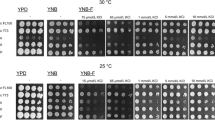Summary
In Saccharomyces cerevisiae, the HGS2-1 allele confers sensitivities to inorganis mercury (Ono and Sakamoto 1985) and to excess fermentable sugars such as glucose (Sakamoto et al. 1985); exogenous tyrosine antagonizes both inorganic mercury and excess glucose. In this sutdy, the inorganic mercury sensitive strain has been shown to have about twice more glucose-1,6-bisphosphate and slightly less pyruvate than the normal strains, suggesting that the inorganic mercury sensitive strain has the reduced aldolase activity. It has been also shown that the growth retarded cells accumulate trehalose, by which the lower level of glucos-6-phosphate in the inorganic mercury sensitive strain is accounted for, and that inorganic mercury, presumably excess glucose also, causes growth inhibition via depletion of cellular tyrosine. The mechanism how cellular tyrosine is depleted by inorganic mercury or excess glucose is accounted for by the facts that (1) the tyrosine uptake activity is decreased with increase of glucose concentration in growth medium, (2) HGS2-1 enhances the effect of glucose on the tyrosine uptake activity, and (3) inorganic mercury inhibits the tyrosine uptake system by binding to its SH-group(s). Thus, it is concluded that the role of tyrosine is not to detoxify inorganic mercury nor excess fermentable sugars but simply to counteract depletion of cellular tyrosine induced by them.
Similar content being viewed by others
References
Cooper TG (1982) In: Strathern JN, Jones EW, Broach JR (eds) The molecular biology of the yeast Saccharomyces, pt 2. Cold Spring Harbor Laboratory, Cold Spring Harbor, New York, pp 399–461
Entian K-D (1977) Mol Gen Genet 158:201–210
Fonzi WA, Shanley M, Opheim DJ (1979) J Bacteriol 173:285–294
Fraenkel DG (1982) In: Strathern JN, Jones EW, Broach JR (eds) The molecular biology of the yeast Saccharomyces, pt 2. Cold Spring Harbor Laboratory, Cold Spring Harbor, New York, pp 1–37
Grenson M, Hou C, Crabeel M (1970) J Bacteriol 103:770–777
Gresham RL, Moat AG (1973) J Bacteriol 115:975–981
Jones EW, Fink RF (1982) In: Strathern JN, Jones EW, Broach JR (eds) The molecular biology of yeast Saccharomyces, pt 2. Cold Spring Harbor Laboratory, Cold Spring Harbor, New York, pp 181–299
Kane M, Roth B (1974) J Bacteriol 118:8–14
Lang G, Michal G (1965) In: Bergmeyer HU (ed) Methods of enzymatic analysis. Academic Press, London, pp 1239–1242
Michal G, Beutler H-O (1965) In: Bergmeyer HU (ed) Methods of enzymatic analysis. Academic Press, London, pp 1314–1319
Ono B, Sakamoto E (1985) Curr Genet 10:179–185
Roon RG, Meyer GM, Larimore FS (1977) Mol Gen Genet 158:185–191
Sakamoto E, Urata H, Ono B (1985) Curr Genet 10:187–195
Scott Jr, TA, and Melvin EH (1953) Anal Chem 25:1656–1661
Trevelyan WE, Harrison JS (1956) Biochem J 63:23–33
Author information
Authors and Affiliations
Rights and permissions
About this article
Cite this article
Ono, Bi., Sakamoto, E. & Yamaguchi, K. Saccharomyces cerevisiae strains sensitive to inorganic mercury. Curr Genet 11, 399–406 (1987). https://doi.org/10.1007/BF00378183
Received:
Issue Date:
DOI: https://doi.org/10.1007/BF00378183




